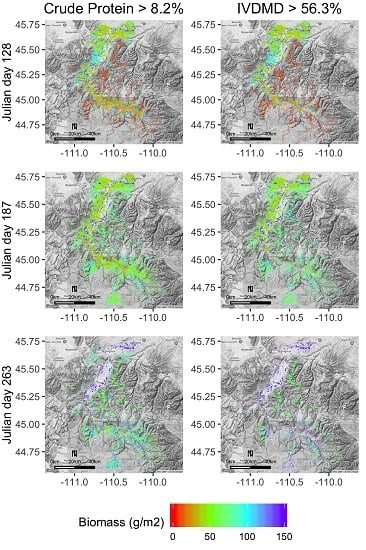Using NDVI and EVI to Map Spatiotemporal Variation in the Biomass and Quality of Forage for Migratory Elk in the Greater Yellowstone Ecosystem
Abstract
:1. Introduction
2. Study Area
3. Data
3.1. Identification and Classification of Grassland Pixels
3.2. Field Estimation of Biomass, Chlorophyll, Crude Protein, and Digestibility
3.3. NDVI and EVI Data
4. Methods
4.1. Accuracy of NDVI and EVI Differed Across Phenology and Land Use Gradients
4.2. Top Models of Grassland Biomass and Quality
4.3. Spatiotemporal Variation in the Abundance of High Quality Forage for Elk
5. Results
5.1. Linear NDVI and EVI Models Explained Minimal Variation in Biomass and Quality
5.2. Polynomial NDVI and Date Effects Improved Models of Biomass and Quality
5.3. Spatiotemporal Variation in Grassland Biomass and Quality Across the UYRB
5.4. Spatiotemporal Variation in the Abundance of High Quality Forage for Elk
6. Discussion
6.1. NDVI and EVI Explained Minimal Variation in Forage Biomass and Quality
6.2. Polynomial NDVI and Date Effects Improved Models of Biomass and Quality
6.3. Spatiotemporal Variation in Grassland Biomass and Quality Across the UYRB
6.4. Spatiotemporal Variation in the Abundance of High Quality Forage for Elk
6.5. Limitations
7. Conclusions
- (1)
- Linear NDVI and EVI models explained half of the variation in grassland biomass (R2 = 0.42–0.53), but minimal variation in chlorophyll (R2 = 0.03–0.04), crude protein (R2 = 0.09–0.14), and digestibility (R2 = 0.11–0.18) across the UYRB. The accuracy of these models was lowest in grasslands with late onset of growth due to contamination from variable terrain, in irrigated agriculture due to moisture contamination, and late in the season due to contamination from senescent vegetation. NDVI-based models explained more variation in forage biomass and quality than EVI-based models, potentially because of the sensitivity of EVI to heterogeneous terrain. Caution should be used, therefore, when using NDVI and EVI as proxies for forage biomass and quality in the UYRB.
- (2)
- Models that accounted for the curvilinear relationship between NDVI and biomass, the seasonal decline in forage quality, and local variation between pixels explained 19%–55% more variation in biomass and 14%–69% more variation in forage quality than the linear NDVI and EVI models. These models projected greater spatiotemporal heterogeneity in forage biomass and quality across the landscape compared to the linear NDVI and EVI models. Understanding the limitations of NDVI and EVI is necessary, therefore, when using these indices to map the patterns of forage available to elk across the UYRB.
- (3)
- Forage biomass and quality varied along the elevation-related phenology gradient, but remained consistently high in irrigated agriculture throughout the growing season. At their seasonal peak, the abundance of forage of adequate quality for elk was up to 50% greater in grasslands with late onset of growth and up to 200% greater in irrigated agriculture than in all other grasslands throughout the growing season. These results may indicate that high-elevation grasslands and irrigated agriculture may play an especially important role in the movement and fitness of elk in the UYRB.
Acknowledgments
Author Contributions
Conflicts of Interest
Appendix
| Model Description | Variable Combinations 1 |
|---|---|
| Linear NDVI/EVI only | NDVI/EVI + random (pixel) |
| Linear NDVI/EVI with SOS/LU | NDVI/EVI + SOS/LU + random (pixel) |
| Linear NDVI/EVI with Date | NDVI/EVI + Date + random (pixel) |
| Linear NDVI/EVI with SOS/LU and Date | NDVI/EVI+SOS/LU + Date + random (pixel) |
| Linear NDVI/EVI with NDVI/EVI*SOS/LU interaction | NDVI/EVI*SOS/LU + random (pixel) |
| Linear NDVI/EVI with NDVI/EVI*Date interaction | NDVI/EVI*Date + random (pixel) |
| Linear NDVI/EVI with NDVI/EVI*SOS/LU interaction and Date | NDVI/EVI*SOS/LU + Date + random (pixel) |
| Linear NDVI/EVI with NDVI/EVI*Date interaction and SOS/LU | NDVI/EVI*Date + SOS/LU + random (pixel) |
| Models 1–8 with quadratic NDVI/EVI effect | NDVI/EVI2 + “ ” |
| Models 1–8 with cubic NDVI/EVI effect | NDVI/EVI3 + “ “ |
| Models 1–8 with basis spline NDVI/EVI effect | bs(NDVI/EVI, df = 5) + “ “ |
| All previous models with variance structure | “ ” + varIdent (SOS/LU) |
| All previous models with temporal autocorrelation | “ ” + corAR1 (Date) |
| All previous models with spatial autocorrelation | “ ” + corExp (Site) |
| All previous models with variance structure and temporal autocorrelation | “ ” + varIdent (SOS/LU) + corAR1 (Date) |
| All previous models with variance structure and spatial autocorrelation | “ ” +varIdent(SOS/LU) + corExp (Site) |
References
- Myneni, R.B.; Hall, F.G.; Sellers, P.J.; Marshak, A.L. Interpretation of spectral vegetation indexes. IEEE Trans. Geosci. Remote Sens. 1995, 33, 481–486. [Google Scholar] [CrossRef]
- Hamel, S.; Garel, M.; Festa-Bianchet, M.; Gaillard, J.M.; Côté, S.D. Spring Normalized Difference Vegetation Index (NDVI) predicts annual variation in timing of peak faecal crude protein in mountain ungulates. J. Appl. Ecol. 2009, 46, 582–589. [Google Scholar] [CrossRef]
- Pettorelli, N.; Ryan, S.; Mueller, T.; Bunnefeld, N.; Jedrzejewska, B.; Lima, M.; Kausrud, K. The Normalized Difference Vegetation Index (NDVI): Unforeseen successes in animal ecology. Clim. Res. 2011, 46, 15–27. [Google Scholar] [CrossRef]
- Kerr, J.T.; Ostrovsky, M. From space to species: Ecological applications for remote sensing. Trends Ecol. Evol. 2003, 18, 299–305. [Google Scholar] [CrossRef]
- Huete, A.; Didan, K.; Miura, T.; Rodriguez, E.P.; Gao, X.; Ferreira, L.G. Overview of the radiometric and biophysical performance of the MODIS vegetation indices. Remote Sens. Environ. 2002, 83, 195–213. [Google Scholar] [CrossRef]
- Jiang, Z.; Huete, A.R.; Didan, K.; Miura, T. Development of a two-band enhanced vegetation index without a blue band. Remote Sens. Environ. 2008, 112, 3833–3845. [Google Scholar] [CrossRef]
- Tucker, C.; Vanpraet, C.; Boerwinkel, E.; Gaston, A. Satellite remote sensing of total dry matter production in the Senegalese Sahel. Remote Sens. Environ. 1983, 13, 461–474. [Google Scholar] [CrossRef]
- Christianson, D.; Creel, S. Fecal chlorophyll describes the link between primary production and consumption in a terrestrial herbivore. Ecol. Appl. 2009, 19, 1323–1335. [Google Scholar] [CrossRef] [PubMed]
- Jones, C.L.; Weckler, P.R.; Maness, N.O.; Jayasekara, R.; Stone, M.L.; Chrz, D. Remote sensing to estimate chlorophyll concentration in spinach using multi-spectral plant reflectance. Am. Soc. Agric. Biol. Eng. 2007, 50, 2267–2273. [Google Scholar]
- Paruelo, J.M.; Epstein, H.E.; Lauenroth, W.K.; Burke, I.C. ANPP estimates from NDVI for the central grassland region of the United States. Ecology 1997, 78, 953–958. [Google Scholar] [CrossRef]
- Thein, T.R.; Watson, F.G.R.; Cornish, S.S.; Anderson, T.N.; Newman, W.B.; Lockwood, R.E. Chapter 7 Vegetation Dynamics of Yellowstone’s Grazing System. Terr. Ecol. 2008, 3, 113–133. [Google Scholar]
- Lendrum, P.E.; Anderson, C.R.; Monteith, K.L.; Jenks, J.A.; Bowyer, R.T. Relating the movement of a rapidly migrating ungulate to spatiotemporal patterns of forage quality. Mamm. Biol. 2014, 79, 369–375. [Google Scholar] [CrossRef]
- Neumann, W.; Martinuzzi, S.; Estes, A.B.; Pidgeon, A.M.; Dettki, H.; Ericsson, G.; Radeloff, V.C. Opportunities for the application of advanced remotely-sensed data in ecological studies of terrestrial animal movement. Mov. Ecol. 2015, 3, 8. [Google Scholar] [CrossRef] [PubMed]
- Borowik, T.; Pettorelli, N.; Sönnichsen, L.; Jedrzejewska, B. Normalized difference vegetation index (NDVI) as a predictor of forage availability for ungulates in forest and field habitats. Eur. J. Wildl. Res. 2013, 59, 675–682. [Google Scholar] [CrossRef]
- Parmesan, C.; Parmesan, C.; Yohe, G.; Yohe, G. A globally coherent fingerprint of climate change impacts across natural systems. Nature 2003, 421, 37–42. [Google Scholar] [CrossRef] [PubMed]
- Middleton, A.D.; Kauffman, M.J.; Mcwhirter, D.E.; Cook, J.G.; Cook, R.C.; Nelson, A.A.; Jimenez, M.D.; Klaver, R.W. Animal migration amid shifting patterns of phenology and predation: Lessons from a Yellowstone elk herd. Ecology 2013, 94, 1245–1256. [Google Scholar] [CrossRef] [PubMed]
- Van Soest, P.J. Nutritional Ecology of the Ruminant, 2nd ed.; Cornstock Publishing Associates: Ithaca, NY, USA, 1982; pp. 40–290. [Google Scholar]
- Ryan, S.J.; Knechtel, C.U.; Getz, W.M. Range and habitat selection of African buffalo in South Africa. J. Wildl. Manag. 2006, 70, 764–776. [Google Scholar] [CrossRef]
- Hebblewhite, M.; Merrill, E.; McDermid, G. A multi-scale test of the forage maturation hypothesis in a partially migratory ungulate population. Ecol. Monogr. 2008, 78, 141–166. [Google Scholar] [CrossRef]
- Matsushita, B.; Yang, W.; Chen, J.; Onda, Y.; Qiu, G. Sensitivity of the Enhanced Vegetation Index (EVI) and Normalized Difference Vegetation Index (NDVI) to topographic effects: A case study in high-density cypress forest. Sensors 2007, 7, 2636–2651. [Google Scholar] [CrossRef]
- Gao, X.; Huete, A.R.; Ni, W.; Miura, T. Optical-biophysical relationships of vegetation spectra without background contamination. Remote Sens. Environ. 2000, 74, 609–620. [Google Scholar] [CrossRef]
- Huete, A.R.; Jackson, R.D.; Post, D.F. Spectral response of a plant canopy with different soil backgrounds. Remote Sens. Environ. 1985, 17, 37–53. [Google Scholar] [CrossRef]
- Tucker, C.J. Asymptotic nature of grass canopy spectral reflectance. Appl. Opt. 1977, 16, 1151–1156. [Google Scholar] [CrossRef] [PubMed]
- Lawrence, R.L.; Ripple, W.J. Comparisons among vegetation indices and bandwise regression in a highly disturbed, heterogeneous landscape: Mount St. Helens, Washington. Remote Sens. Environ. 1998, 64, 91–102. [Google Scholar] [CrossRef]
- Tanre, D.; Holben, B.N.; Kaufman, Y.J. Atmospheric correction algorithm for NOAA-AVHRR products: Theory and application. IEEE Trans. Geosci. Remote Sens. 1992, 30, 231–248. [Google Scholar] [CrossRef]
- Tucker, C.J. A critical review of remote sensing and other methods for non-destructive estimation of standing crop biomass. Grass Forage Sci. 1980, 35, 177–182. [Google Scholar] [CrossRef]
- Tittebrand, A.; Spank, U.; Bernhofer, C.H. Comparison of satellite and ground-based NDVI above different land-use types. Theor. Appl. Climatol. 2009, 98, 171–186. [Google Scholar] [CrossRef]
- Porter, T.F.; Chen, C.; Long, J.A.; Lawrence, R.L.; Sowell, B.F. Estimating biomass on CRP pastureland: A comparison of remote sensing techniques. Biomass Bioenergy 2014, 66, 268–274. [Google Scholar] [CrossRef]
- Guerschman, J.P.; Paruelo, J.M.; Burke, I.C. Land use impacts on the normalized difference vegetation index in temperate Argentina. Ecol. Appl. 2003, 13, 616–628. [Google Scholar] [CrossRef]
- Garonna, I.; Fazey, I.; Brown, M.E.; Pettorelli, N. Rapid primary productivity changes in one of the last coastal rainforests: the case of Kahua, Solomon Islands. Environ. Conserv. 2009, 36, 253–260. [Google Scholar] [CrossRef]
- Santin-Janin, H.; Garel, M.; Chapuis, J.L.; Pontier, D. Assessing the performance of NDVI as a proxy for plant biomass using non-linear models: A case study on the kerguelen archipelago. Polar Biol. 2009, 32, 861–871. [Google Scholar] [CrossRef]
- Gurung, R.B.; Breidt, F.J.; Dutin, A.; Ogle, S.M. Predicting Enhanced Vegetation Index (EVI) curves for ecosystem modeling applications. Remote Sens. Environ. 2009, 113, 2186–2193. [Google Scholar] [CrossRef]
- Maynard, C.; Lawrence, R.; Nielsen, G.; Decker, G. Modeling vegetation amount using bandwise regression and ecological site descriptions as an alternative to vegetation indices. GISci. Remote Sens. 2007, 44, 68–81. [Google Scholar] [CrossRef]
- Thoma, D.P.; Bailey, D.W.; Long, D.S.; Nielsen, G.A.; Henry, M.P.; Breneman, M.C.; Montagne, C. Short-term monitoring of rangeland forage conditions with AVHRR imagery. J. Range Manag. 2002, 55, 383–389. [Google Scholar] [CrossRef]
- Liu, H.Q.; Huete, A. A feedback based modification of the NDVI to minimize canopy background and atmospheric noise. IEEE Trans. Geosci. Remote Sens. 1995, 33, 457–465. [Google Scholar]
- Kawamura, K.; Akiyama, T.; Yokota, H.; Tsutsumi, M.; Yasuda, T.; Watanabe, O.; Wang, S. Comparing MODIS vegetation indices with AVHRR NDVI for monitoring the forage quantity and quality in Inner. Grassl. Sci. 2005, 51, 33–40. [Google Scholar] [CrossRef]
- Sesnie, S.E.; Dickson, B.G.; Rosenstock, S.S.; Rundall, J.M. A comparison of Landsat TM and MODIS vegetation indices for estimating forage phenology in desert bighorn sheep (Ovis canadensis nelsoni) habitat in the Sonoran Desert, USA. Int. J. Remote Sens. 2011, 33, 276–286. [Google Scholar] [CrossRef]
- Cook, J.; Johnson, B.; Cook, R.; Riggs, R.; Delcurto, T.; Bryant, L.; Irwin, L. Effects of summer-autumn nutrition and parturition date on reproduction and survival of elk. Wildl. Monogr. 2004, 155, 1–61. [Google Scholar]
- Fryxell, J.M. Forage quality and aggregation by large herbivores. Am. Nat. 1991, 138, 478. [Google Scholar] [CrossRef]
- Christianson, D.; Creel, S. Effects of grass and browse consumption on the winter mass dynamics of elk. Oecologia 2009, 158, 603–613. [Google Scholar] [CrossRef] [PubMed]
- Baker, D.L.; Hobbs, N.T. Composition and quality of elk (Cervus elaphus nelsoni) summer diets in Colorado, USA. J. Wildl. Manag. 1982, 46, 694–703. [Google Scholar] [CrossRef]
- Alldredge, M.W.; Peek, J.M.; Wall, W. Nutritional quality of forages used by elk in northern Idaho. J. Range Manag. 2002, 55, 253–259. [Google Scholar] [CrossRef]
- Houston, D. The Northern Yellowstone Elk: Ecology and Management, 1st ed.; Collier Macmillan: New York, NY, USA, 1982; pp. 1–474. [Google Scholar]
- Frank, D.A.; McNaughton, S.J.; Tracy, B.F. The ecology of the earth’s grazing ecosystems. Bioscience 1998, 48, 513–521. [Google Scholar] [CrossRef]
- Haggerty, J.H.; Travis, W.R. Out of administrative control: Absentee owners, resident elk and the shifting nature of wildlife management in southwestern Montana. Geoforum 2006, 37, 816–830. [Google Scholar] [CrossRef]
- Parmenter, A.W.; Hansen, A.; Kennedy, R.E.; Cohen, W.; Langner, U.; Lawrence, R.; Maxwell, B.; Gallant, A.; Aspinall, R. Land use and land cover change in the Greater Yellowstone Ecosystem: 1975–1995. Ecol. Appl. 2003, 13, 687–703. [Google Scholar] [CrossRef]
- Piekielek, N.B. Remote Sensing Grassland Phenology in the Greater Yellowstone Ecosystem: Biophysical Correlates, Land Use Effects and Patch Dynamics. Ph.D. Thesis, Montana State University, Bozeman, MT, USA, 2012. [Google Scholar]
- Son, N.T.; Chen, C.F.; Chen, C.R.; Minh, V.Q.; Trung, N.H. A comparative analysis of multitemporal MODIS EVI and NDVI data for large-scale rice yield estimation. Agric. For. Meteorol. 2014, 197, 52–64. [Google Scholar] [CrossRef]
- Fontana, F.; Rixen, C.; Jonas, T.; Aberegg, G.; Wunderle, S. Alpine grassland phenology as seen in AVHRR, VEGETATION, and MODIS NDVI time series—A comparison with in situ measurements. Sensors 2008, 8, 2833–2853. [Google Scholar] [CrossRef]
- Houston, D.B. Elk as winter-spring food for carnivores in Northern Yellowstone National Park. J. Appl. Ecol. 1978, 15, 653–661. [Google Scholar] [CrossRef]
- Despain, D. Yellowstone Vegetation: Consequences of Environment and History in a Natural Setting; Roberts Rinehart Inc.: Boulder, MT, USA, 1990. [Google Scholar]
- Homer, C.G.; Dewitz, J.A.; Yang, L.; Jim, S.; Daniselson, P.; Xian, G.; Coulston, J.; Herold, N.D.; Wickham, J.D.; Megown, K. Completion of the 2011 National Land Cover Database for the conterminous United States-Representing a decade of land cover change information. Photogramm. Eng. Remote Sens. 2015, 81, 345–354. [Google Scholar]
- Justice, C.O.; Townshend, J.R.G.; Vermote, E.F.; Masuoka, E.; Wolfe, R.E.; Saleous, N.; Roy, D.P.; Morisette, J.T. An overview of MODIS Land data processing and product status. Remote Sens. Environ. 2002, 83, 3–15. [Google Scholar] [CrossRef]
- Garroutte, E.; Hansen, A. Spatiotemporal variation in the biomass and quality across elevation-related phenology and land use gradients in the Upper Yellowstone River Basin. Unpublished work. 2016. [Google Scholar]
- Zuur, A.F.; Ieno, E.N.; Walker, N.J.; Saveliev, A.A.; Smith, G.M. Mixed effects models and extensions in ecology with R. J. R. Stat. Soc.: Ser. A 2010, 173, 938–939. [Google Scholar]
- Box, G.E.P.; Jenkins, G.M. Time Series Analysis: Forecasting and Control, 4th ed.; Wiley: Englewood Cliffs, NJ, USA, 1994; Volume 3. [Google Scholar]
- Nakagawa, S.; Schielzeth, H. A general and simple method for obtaining R2 from generalized linear mixed-effects models. Methods Ecol. Evol. 2013, 4, 133–142. [Google Scholar] [CrossRef]
- Baptist, F.; Yoccoz, N.G.; Choler, P. Direct and indirect control by snow cover over decomposition in alpine tundra along a snowmelt gradient. Plant Soil 2010, 328, 397–410. [Google Scholar] [CrossRef]
- Bowman, W.D.; Theodose, T.A.; Schardt, J.C.; Conant, R.T. Constraints of nutrient availability on primary production in two alpine tundra communities. Ecology 1993, 74, 2085–2097. [Google Scholar] [CrossRef]
- Blumthaler, M.; Ambach, W.; Ellinger, R. Increase in solar UV radiation with altitude. J. Photochem. Photobiol. B Biol. 1997, 39, 130–134. [Google Scholar] [CrossRef]
- Brooks, P.D.; Williams, M.W. Snowpack controls on nitrogen cycling and export in seasonally snow-covered catchments. Hydrol. Process. 1999, 13, 2177–2190. [Google Scholar] [CrossRef]
- Borner, A.P.; Kielland, K.; Walker, M.D. Effects of simulated climate change on plant phenology and Nitrogen mineralization in Alaskan Arctic Tundra. Arct. Antarct. Alp. Res. 2008, 40, 27–38. [Google Scholar] [CrossRef]
- Kudo, G.; Nordenhall, U.; Molau, U. Effects of snowmelt timing on leaf traits, leaf production, and shoot growth of alpine plants: Comparisons along a snowmelt gradient in northern Sweden. Ecoscience 1999, 6, 439–450. [Google Scholar]
- Frank, D.A.; Groffman, P.M. Ungulate vs. landscape control of soil C and N processes in grasslands of Yellowstone National Park. Ecology 1998, 79, 2229–2241. [Google Scholar] [CrossRef]
- Albon, S.D.; Langvatn, R. Plant phenology and the benefits of migration in a temperate ungulate. Oikos 2009, 65, 502–513. [Google Scholar] [CrossRef]
- Hebblewhite, M.; Merrill, E.H. Trade-offs between predation risk and forage differ between migrant strategies in a migratory ungulate. Ecology 2009, 90, 3445–3454. [Google Scholar] [CrossRef] [PubMed]
- Duparc, A.; Redjadj, C.; Viard-Crétat, F.; Lavorel, S.; Austrheim, G.; Loison, A. Co-variation between plant above-ground biomass and phenology in sub-alpine grasslands. Appl. Veg. Sci. 2013, 16, 305–316. [Google Scholar] [CrossRef]
- Inouye, D.W. Effects of climate change on phenology, frost damage, and floral abundance of montane wildflowers. Ecology 2008, 89, 353–362. [Google Scholar] [CrossRef] [PubMed]
- Buyantuyev, A.; Wu, J. Urbanization alters spatiotemporal patterns of ecosystem primary production: A case study of the Phoenix metropolitan region, USA. J. Arid Environ. 2009, 73, 512–520. [Google Scholar] [CrossRef]
- Wilmers, C.C.; Levi, T. Do irrigation and predator control reduce the productivity of migratory ungulate herds? Ecology 2013, 94, 1264–1270. [Google Scholar] [CrossRef] [PubMed]
- White, R.G. Foraging Patterns and Their Multiplier Effects on Productivity of Northern Ungulates. Oikos 1983, 40, 377–384. [Google Scholar] [CrossRef]
- Mysterud, A.; Langvatn, R.; Yoccoz, N.G.; Stenseth, N.C. Plant phenology, migration and geographical variation in body weight of a large herbivore: The effect of a variable topography. J. Anim. Ecol. 2001, 70, 915–923. [Google Scholar] [CrossRef]
- Bischof, R.; Loe, L.E.; Meisingset, E.L.; Zimmermann, B.; van Moorter, B.; Mysterud, A. A migratory northern ungulate in the pursuit of spring: Jumping or surfing the green wave? Am. Nat. 2012, 180, 407–424. [Google Scholar] [CrossRef] [PubMed]
- Hebblewhite, M.; Merrill, E.H.; Morgantini, L.E.; White, C.A.; Allen, J.R.; Bruns, E.; Thurston, L.; Hurd, T.E. Is the migratory behavior of montane elk herds in Peril? The case of Alberta’s Ya Ha Tinda elk herd. Wildl. Soc. Bull. 2006, 34, 1280–1294. [Google Scholar] [CrossRef]
- Creel, S.; Winnie, J.; Maxwell, B.; Hamlin, K.; Creel, M. Elk alter habitat selection as an antipredator response to wolves. Ecology 2005, 86, 3387–3397. [Google Scholar] [CrossRef]
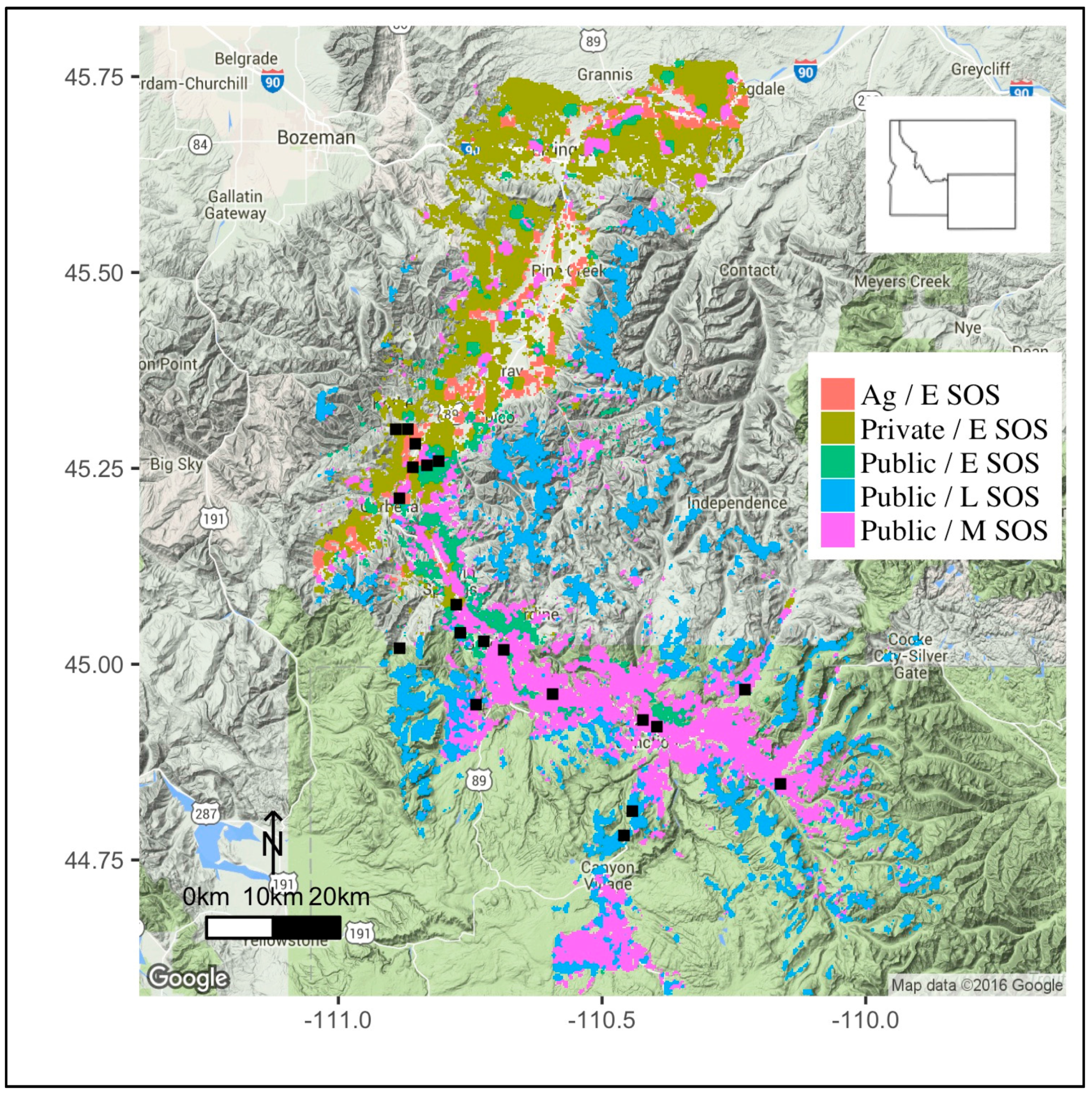
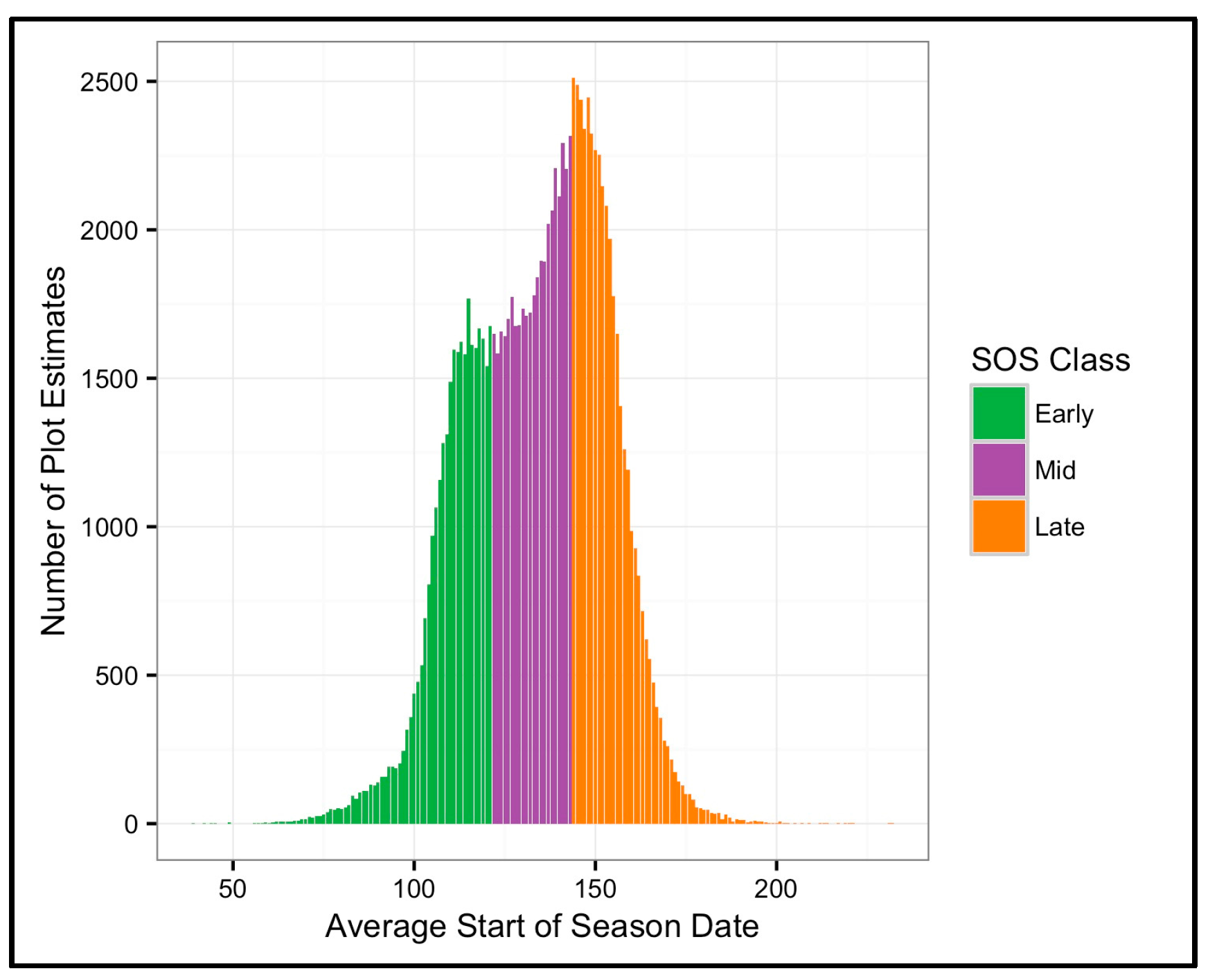
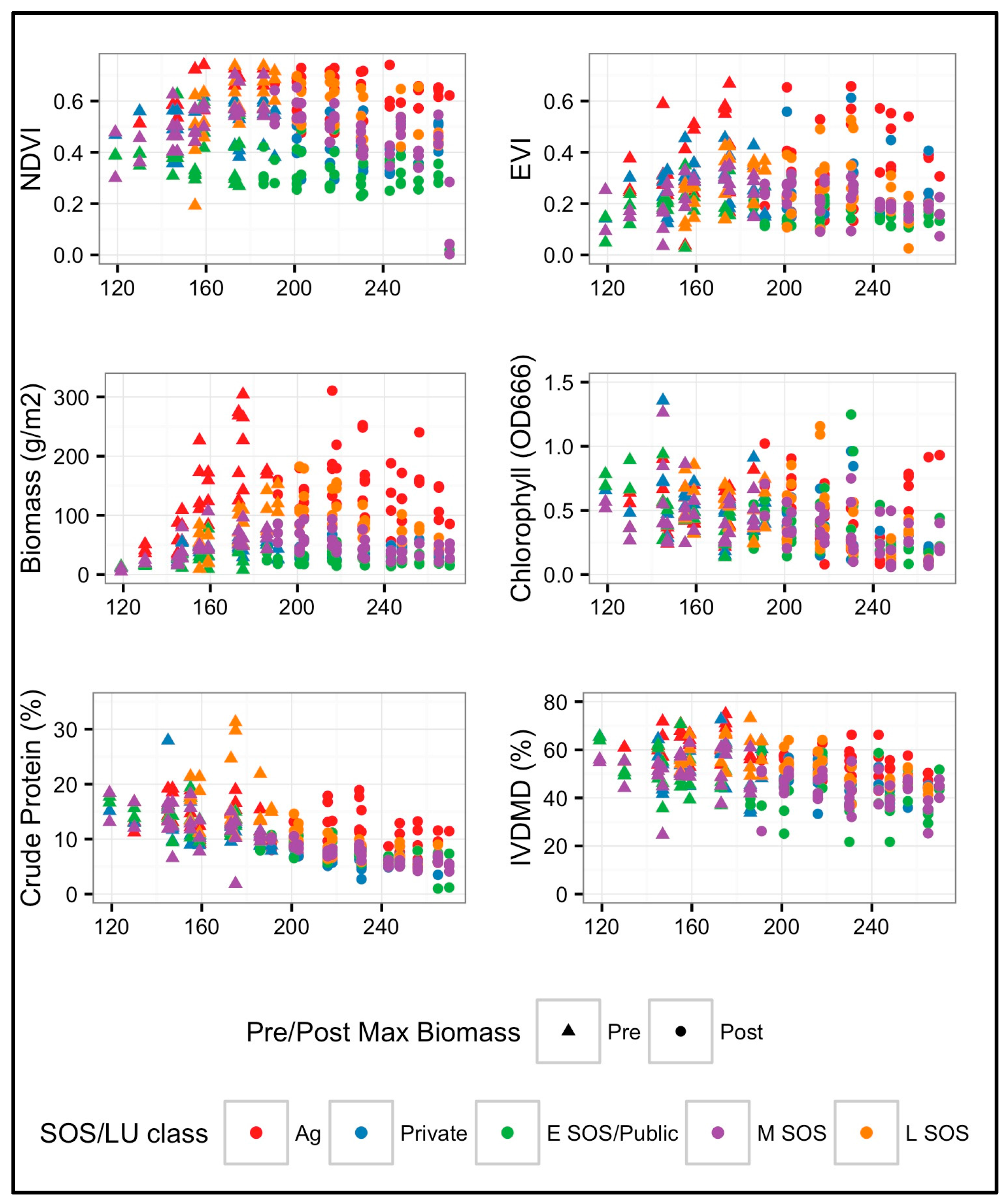
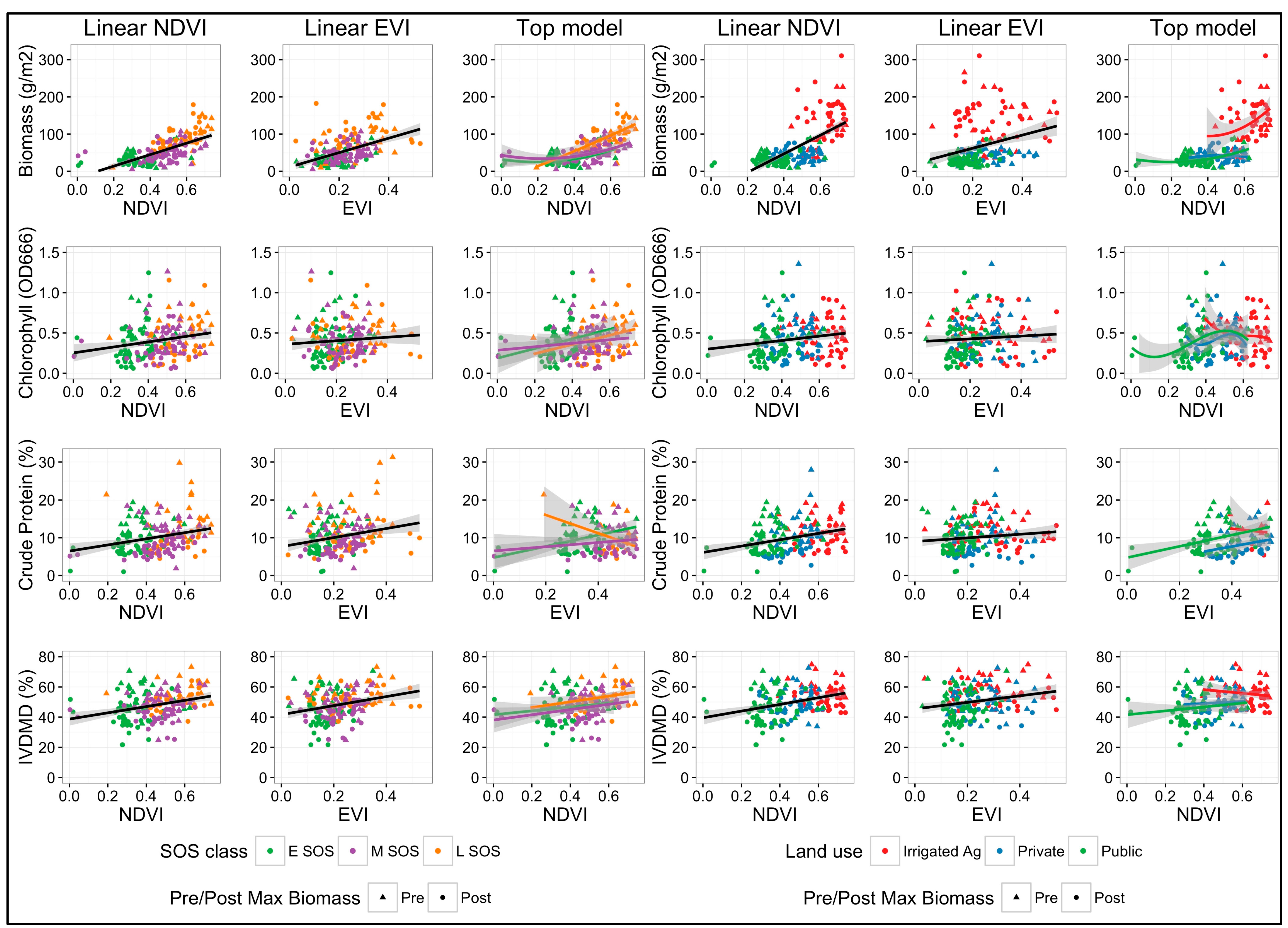
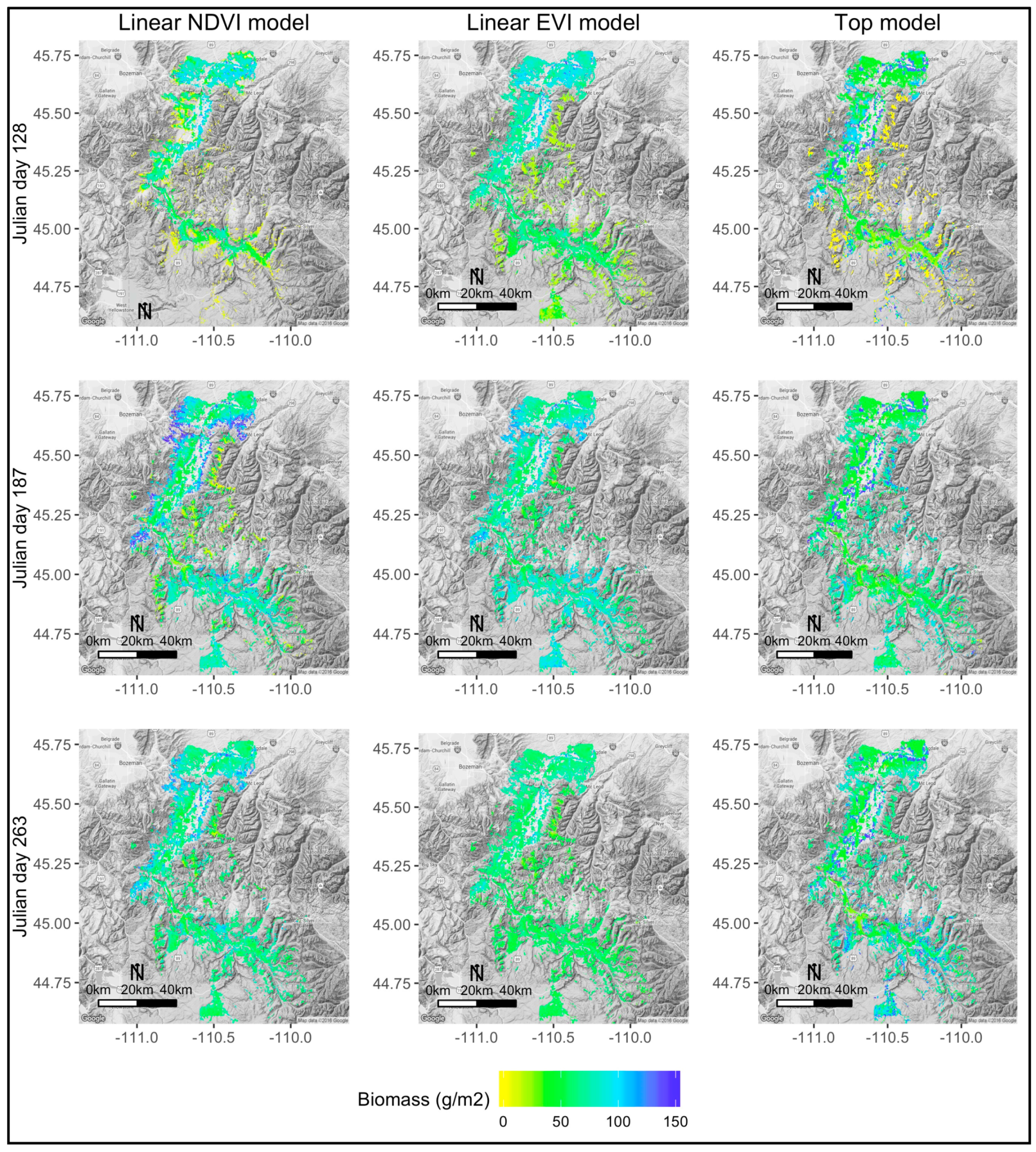
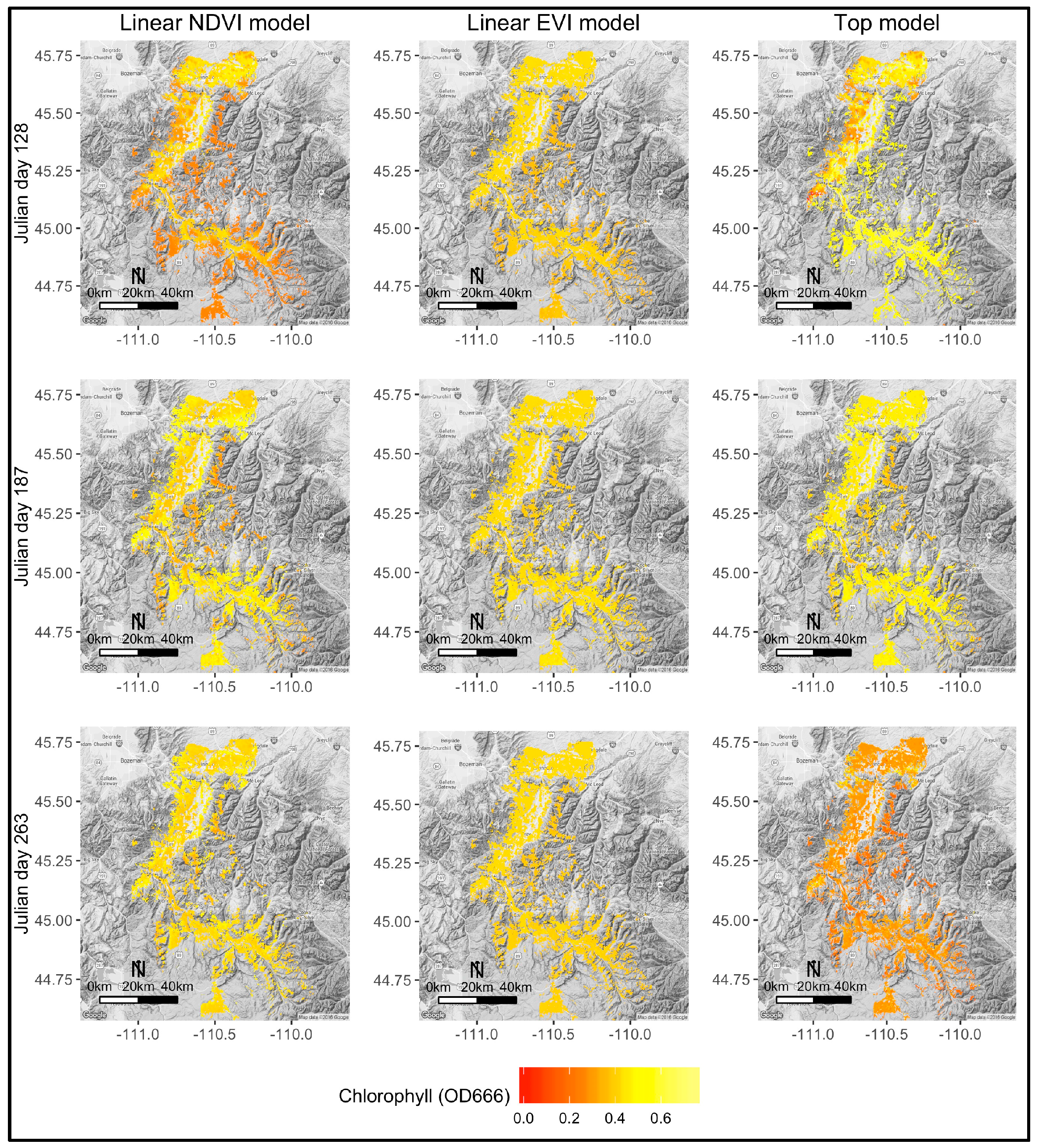
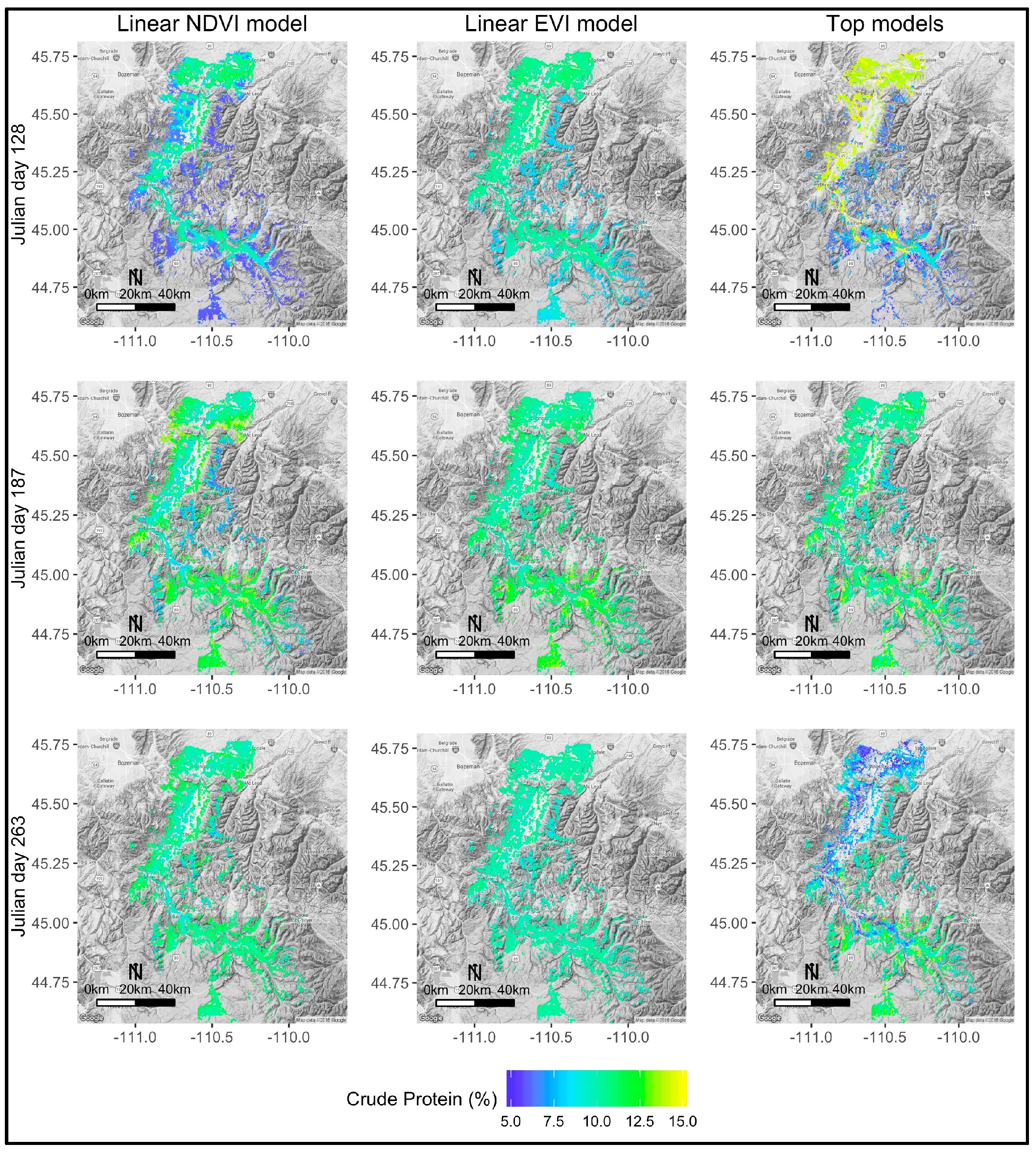
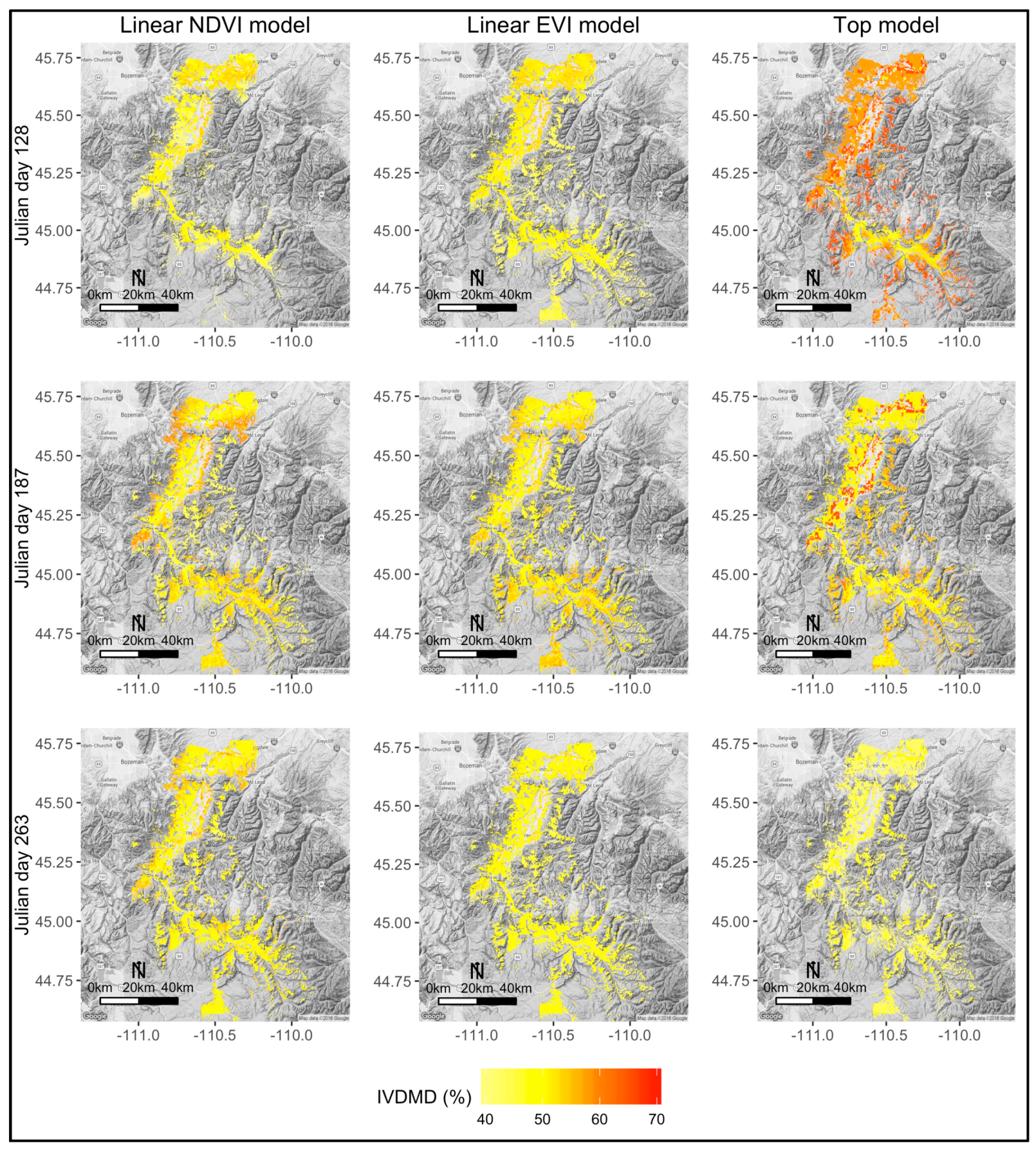

| Start of Season Models | Land Use Models | ||||||||||||||||
|---|---|---|---|---|---|---|---|---|---|---|---|---|---|---|---|---|---|
| AICc | R2 | Fixed Effects | rp2 | df | F | p | Model | AICc | R2 | Fixed Effects | rp2 | df | F | p | |||
| Aboveground biomass | |||||||||||||||||
| NDVI | 1782.7 | 0.42 | NDVI | 0.42 | 1187 | 134.1 | <0.001 | NDVI | 2113.8 | 0.53 | NDVI | 0.53 | 1198 | 226.7 | <0.001 | ||
| EVI | 1834.9 | 0.24 | EVI | 0.24 | 1187 | 57.2 | <0.001 | EVI | 2228.9 | 0.17 | EVI | 0.17 | 1198 | 40.8 | <0.001 | ||
| Top | 1662.5 | 0.76 | bs(NDVI) | 0.59 | 5160 | 13.1 | <0.001 | Top | 1826.7 | 0.72 | NDVI2 | 0.62 | 2181 | 53.8 | <0.001 | ||
| SOS | 0.08 | 2160 | 12.9 | <0.001 | Land use | 0.07 | 211 | 30.5 | <0.001 | ||||||||
| bs(NDVI)*SOS | 0.09 | 10,160 | 3.7 | <0.001 | Date | 0.01 | 1181 | 0.6 | 0.44 | ||||||||
| NDVI2*Date | 0.02 | 2181 | 14.4 | <0.001 | |||||||||||||
| Chlorophyll | |||||||||||||||||
| NDVI | −22.9 | 0.04 | NDVI | 0.04 | 1187 | 8.6 | 0.004 | NDVI | −7.8 | 0.03 | NDVI | 0.03 | 1198 | 6.4 | 0.012 | ||
| EVI | −15.8 | 0.01 | EVI | 0.01 | 1187 | 1.3 | 0.255 | EVI | −1.7 | 0.01 | EVI | 0.01 | 1198 | 0.2 | 0.653 | ||
| Top | −54.8 | 0.21 | NDVI | 0.06 | 1175 | 10.3 | 0.001 | Top | −34.3 | 0.17 | NDVI | 0.06 | 1184 | 7.4 | 0.007 | ||
| Date | 0.15 | 1175 | 39.1 | <0.001 | Date | 0.11 | 1184 | 32.7 | <0.001 | ||||||||
| Crude protein | |||||||||||||||||
| NDVI | 1098.5 | 0.09 | NDVI | 0.09 | 1187 | 18.9 | <0.001 | NDVI | 1114.9 | 0.14 | NDVI | 0.14 | 1198 | 31.4 | <0.001 | ||
| EVI | 1106.4 | 0.05 | EVI | 0.05 | 1187 | 10.4 | 0.001 | EVI | 1132.8 | 0.05 | EVI | 0.05 | 1198 | 11.7 | <0.001 | ||
| Top | 896.9 | 0.74 | bs(EVI) | 0.16 | 5169 | 15.3 | <0.001 | Top | 971.7 | 0.51 | bs(EVI) | 0.14 | 5180 | 18.8 | <0.001 | ||
| SOS | 0.04 | 2169 | 3.3 | 0.041 | Land use | 0.06 | 211 | 5.9 | 0.018 | ||||||||
| Date | 0.54 | 1169 | 328.9 | <0.001 | Date | 0.31 | 1180 | 236.1 | <0.001 | ||||||||
| IVDMD | |||||||||||||||||
| NDVI | 1369.7 | 0.11 | NDVI | 0.11 | 1187 | 22.2 | <0.001 | NDVI | 1453.9 | 0.18 | NDVI | 0.18 | 1198 | 44.6 | <0.001 | ||
| EVI | 1375.9 | 0.08 | EVI | 0.08 | 1187 | 15.5 | <0.001 | EVI | 1481.6 | 0.06 | EVI | 0.06 | 1198 | 13.3 | <0.001 | ||
| Top | 1307.5 | 0.37 | NDVI | 0.12 | 1172 | 31.7 | <0.001 | Top | 1383.2 | 0.56 | NDVI2 | 0.22 | 2183 | 34.8 | <0.001 | ||
| SOS | 0.05 | 2172 | 4.1 | 0.018 | Land use | 0.06 | 211 | 7.4 | 0.009 | ||||||||
| Date | 0.18 | 1172 | 60.2 | <0.001 | Date | 0.28 | 1183 | 82.2 | <0.001 | ||||||||
| NDVI*Date | 0.02 | 1172 | 7.7 | 0.006 | |||||||||||||
| Start of Season Classes | Land Use Classes | |||||||||
|---|---|---|---|---|---|---|---|---|---|---|
| Models | Early | Mid | Late | Pre-Max | Post-Max | Irrigated Ag | Private | Public | Pre-Max | Post-Max |
| Aboveground biomass (g/m2) | ||||||||||
| NDVI | 3.88 ± 2.61a | 4.63 ± 3.38a | 7.89 ± 3.41b | 3.41 ± 2.76a | 6.44 ± 3.91b | 18.61 ± 9.58b | 7.66 ± 5.33a | 5.59 ± 4.16a | 7.05 ± 5.68a | 9.07 ± 6.24b |
| EVI | 4.09 ± 2.61a | 4.52 ± 2.71a | 9.17 ± 4.51b | 4.35 ± 3.28a | 6.79 ± 2.99b | 16.85 ± 9.45b | 8.42 ± 5.35a | 6.86 ± 3.67a | 9.14 ± 8.31a | 12.41 ± 9.14b |
| Top | 2.43 ± 2.11a * | 3.22 ± 2.77a * | 5.46 ± 3.36b * | 2.65 ± 2.24a * | 5.02 ± 6.56b * | 12.17 ± 9.92b * | 2.36 ± 1.89a * | 2.69 ± 2.02a * | 4.31 ± 4.63a * | 6.22 ± 5.09b * |
| Chlorophyll (OD666) | ||||||||||
| NDVI | 0.03 ± 0.04a | 0.04 ± 0.03a | 0.05 ± 0.03b | 0.03 ± 0.02a | 0.04 ± 0.03b | 0.05 ± 0.03b | 0.03 ± 0.02a | 0.03 ± 0.02a | 0.03 ± 0.02a | 0.05 ± 0.03b |
| EVI | 0.03 ± 0.04a | 0.04 ± 0.03a | 0.05 ± 0.03b | 0.03 ± 0.02a | 0.04 ± 0.03b | 0.05 ± 0.03b | 0.03 ± 0.03a | 0.03 ± 0.03a | 0.03 ± 0.02a | 0.05 ± 0.03b |
| Top | 0.02 ± 0.04a * | 0.03 ± 0.03a * | 0.03 ± 0.03b * | 0.02 ± 0.03a * | 0.03 ± 0.03b * | 0.05 ± 0.03b * | 0.02 ± 0.03a | 0.02 ± 0.03a | 0.02 ± 0.02a * | 0.03 ± 0.03b * |
| Crude protein (%) | ||||||||||
| NDVI | 0.68 ± 0.53a | 0.73 ± 0.47a | 1.02 ± 0.97b | 0.73 ± 0.41a | 0.99 ± 1.01b | 0.87 ± 0.49b | 0.76 ± 0.58a | 0.67 ± 0.54a | 0.47 ± 0.44a | 0.67 ± 0.56b |
| EVI | 0.68 ± 0.53a | 0.76 ± 0.51a | 1.03 ± 0.98b | 0.79 ± 0.46a | 0.87 ± 1.05b | 0.87 ± 0.49b | 0.73 ± 0.63a | 0.71 ± 0.45a | 0.44 ± 0.46a | 0.55 ± 0.53b |
| Top | 0.38 ± 0.32a * | 0.32 ± 0.38a * | 0.77 ± 0.79b * | 0.32 ± 0.29a * | 0.53 ± 0.84b * | 0.71 ± 0.58b * | 0.41 ± 0.45a * | 0.35 ± 0.29a * | 0.38 ± 0.42a * | 0.45 ± 0.33b * |
| IVDMD (%) | ||||||||||
| NDVI | 1.41 ± 1.17a | 1.51 ± 1.25a | 1.98 ± 1.44b | 1.41 ± 0.91a | 1.53 ± 1.78b | 2.01 ± 1.45b | 1.54 ± 1.06a | 1.71 ± 1.32a | 1.36 ± 1.39a | 1.45 ± 1.42b |
| EVI | 1.56 ± 1.17a | 1.59 ± 1.27a | 2.01 ± 1.44b | 1.47 ± 0.94a | 2.06 ± 1.81b | 2.13 ± 1.46b | 1.71 ± 1.31a | 1.85 ± 1.35a | 1.48 ± 1.24a | 2.05 ± 1.26b |
| Top | 1.08 ± 0.83a * | 1.31 ± 1.11a * | 1.77 ± 1.36b * | 1.24 ± 0.95a * | 1.74 ± 1.35b * | 1.85 ± 1.26b * | 1.11 ± 1.15a * | 1.52 ± 0.91a * | 1.07 ± 1.06a * | 1.46 ± 1.36b * |
© 2016 by the authors; licensee MDPI, Basel, Switzerland. This article is an open access article distributed under the terms and conditions of the Creative Commons Attribution (CC-BY) license (http://creativecommons.org/licenses/by/4.0/).
Share and Cite
Garroutte, E.L.; Hansen, A.J.; Lawrence, R.L. Using NDVI and EVI to Map Spatiotemporal Variation in the Biomass and Quality of Forage for Migratory Elk in the Greater Yellowstone Ecosystem. Remote Sens. 2016, 8, 404. https://doi.org/10.3390/rs8050404
Garroutte EL, Hansen AJ, Lawrence RL. Using NDVI and EVI to Map Spatiotemporal Variation in the Biomass and Quality of Forage for Migratory Elk in the Greater Yellowstone Ecosystem. Remote Sensing. 2016; 8(5):404. https://doi.org/10.3390/rs8050404
Chicago/Turabian StyleGarroutte, Erica L., Andrew J. Hansen, and Rick L. Lawrence. 2016. "Using NDVI and EVI to Map Spatiotemporal Variation in the Biomass and Quality of Forage for Migratory Elk in the Greater Yellowstone Ecosystem" Remote Sensing 8, no. 5: 404. https://doi.org/10.3390/rs8050404
APA StyleGarroutte, E. L., Hansen, A. J., & Lawrence, R. L. (2016). Using NDVI and EVI to Map Spatiotemporal Variation in the Biomass and Quality of Forage for Migratory Elk in the Greater Yellowstone Ecosystem. Remote Sensing, 8(5), 404. https://doi.org/10.3390/rs8050404




